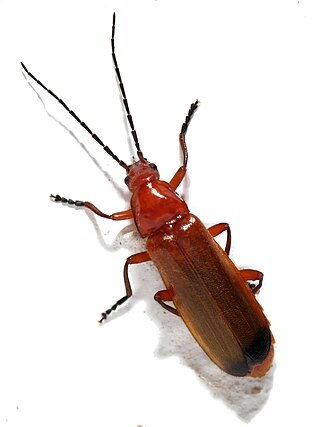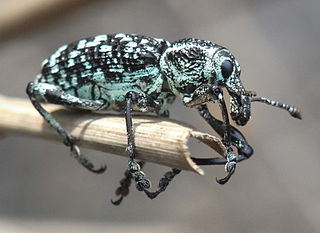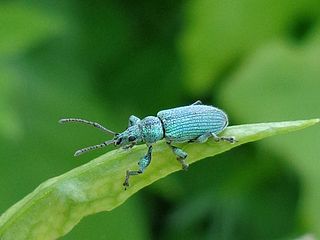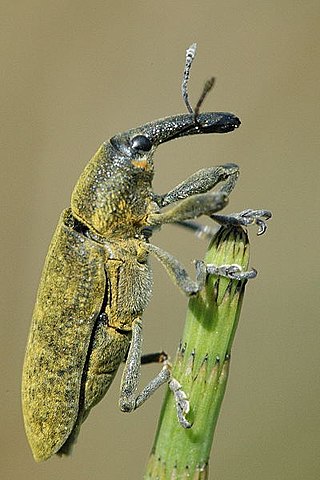
Giovanni Antonio Scopoli was an Italian physician and naturalist. His biographer Otto Guglia named him the "first anational European" and the "Linnaeus of the Austrian Empire".

Phyllobius is a genus of weevils containing at least 60 described species, some of which are commonly found in Europe.

Rhagonycha fulva, the common red soldier beetle, also misleadingly known as the bloodsucker beetle, and popularly known in England as the hogweed bonking beetle is a species of soldier beetle (Cantharidae).

Chrysolopus spectabilis is a species of weevil found in south-eastern Australia. It was discovered during James Cook's first voyage, and became one of the first insects to be described from Australia. The weevil measures up to 25 mm (1.0 in) long and includes distinctive metallic green and black scales. It is found only on 28 species of the plant genus Acacia.

Curculio is a genus of weevils belonging the family Curculionidae and subfamily Curculioninae. Members of the genus are commonly referred to as acorn weevils or nut weevils as they infest the seeds of trees such as oaks and hickories. The adult female weevil bores a tiny hole in the immature nut to lay her eggs, which then hatch into legless grubs. In autumn, the grubs bore holes through the shells from the inside to emerge into the soil where they may live for a year or two before maturing into adults.

Catocala fulminea, the yellow bands underwing, is a moth of the family Erebidae. The species was first described by Giovanni Antonio Scopoli in his 1763 Entomologia Carniolica. It is found in central and southern Europe, east Asia and Siberia. The xarippe lineage has been proposed to be a distinct and valid species in its own right, instead of being only subspecifically distinct.

Entomologia Carniolica exhibens insecta Carnioliae indigena et distributa in ordines, genera, species, varietates is a taxonomic work by Giovanni Antonio Scopoli, published in Vienna in 1763. As well as describing hundreds of new species, Entomologia Carniolica contained observations on the species' biology, including the first published account of queen bees mating outside the hive.

Spilostethus pandurus is a species of "seed bugs" belonging to the family Lygaeidae, subfamily Lygaeinae.

Sternochetus mangiferae is a weevil commonly known as the mango seed weevil, mango stone weevil, or mango weevil. It is a compact weevil typical of the Cryptorhynchinae. It was first described in 1775 in the genus Curculio. The adults are 7.5-9.5 mm long and 4 mm in width.

Curculio elephas is a species of beetle in the family Curculionidae, the true weevils. It is known commonly as the chestnut weevil. It is a serious pest of chestnut in Europe.

Phyllobius argentatus is a species of short-nosed weevil commonly known as the silver-green leaf weevil.

Phyllobius pomaceus is a species of short-nosed weevil commonly known as the nettle weevil.

Ceutorhynchus obstrictus, the cabbage seedpod weevil, is a species of snout beetles or true weevils which is widespread in Europe and lives on several types of crucifers. The adult weevils feed on the leaves, but breed in the seedpods, where the larvae destroy the seeds. It can be a harmful pest on crops like rapeseed/canola, cabbage and relatives or Brassica rapa.

Curculio sayi, the small or lesser chestnut weevil, is a species of true weevil in the family of beetles known as Curculionidae.
Omias is a genus of broad-nosed weevils in the beetle family Curculionidae. There are more than 50 described species in Omias.

Lixus pulverulentus is a species of weevil belonging to the family Curculionidae. The species was scientifically described in 1763 by Giovanni Antonio Scopoli as Curculio pulverulentus Scopoli, 1763.
















